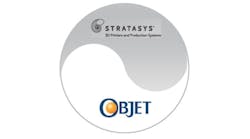The 3-D printing industry saw no shortage of headlines in 2012 as it made its charge at the mainstream manufacturing world.
The industry was simply abubble last year with high profile breakthroughs, powerful startups and exciting new applications. There were government-led initiatives for development, innovations honored, spotlights shined and even some controversy -- all adding to the growing thesis that additive manufacturing really is growing up.
So, without question, 2012 was a big year for 3-D printing. 2013, however, may prove to be even bigger thanks to the long-awaited merger between two of the industry's biggest players, Objet and Stratasys -- a deal that could be enough to push the industry over its last developmental hurdles.
As David Reis, former Objet CEO and current CEO of the newly formed Stratasys Ltd., explained, "The combination of Stratasys and Objet creates a company that can provide manufacturers and designers with the full suite of products to cover all of the design stages."
"The industry is bubbling. There is a lot of activity, a lot of new entries," he said. "But the industry requires larger players" to cope with it.
The potential of 3-D printing industry and of additive manufacturing in general is enormous, based, as he said, "on the fact that we're basically suitable or required by anyone who designs or manufacturers anything."
In order to reach that infinite market, he said, the industry requires large, global companies with the reach and drive required to give them what they need.
After the merger, with a market valuation of $3 billion, dual headquarters at strategic locations in the U.S. and Israel and a mature infrastructure for sales and distribution filling in those 6,000 miles between, the new Stratasys might be the big player the industry has been waiting for.
But that's not the real gift the merger has given the industry. Buried in the details of the deal, the real gift to the industry and to the customers of any additive manufacturing company is the incredible R&D powerhouse the expanded Stratasys is about to become.
A Deal of Two Giants
Reis has no plans to integrate the technology teams of the two sides of the company, which he said represents about 2/3 of the total employees.
"The story behind this merger is growth and sustained growth," he said. "The technologies are very different. It did not make sense on day one to try and integrate the R&D teams and the operations teams."
Rather, "The focus on the merger, from the point of view of activity, is around sales, marketing, finance, customer support and IT. And it's being done on a worldwide basis," he explained.
This is an absolutely genius move.
Objet and Stratasys, as Reis pointed out, have unique, distinct technologies. The former uses an inkjet style printing system (imagine the same inkjet printer under your desk running in three dimensions instead of just two) that allows machines to work with multiple print heads, employing multiple materials simultaneously. This results in a 3-D object printed with high accuracy, high resolution at a very high rate of speed, which is most suitable for early design phases in the concept modeling process.
Stratasys, on the other hand, uses the fused deposition modeling (FDM) process to build up finishes pieces out of layers of molten polymers -- a process proven ideal for functional and direct digital manufacturing.
With such disparate (and complimentary) technologies that have so much history behind them, there is no strategic advantage to mucking up the process with complicated integration efforts. Instead, Reis is focusing on tapping into the infrastructures both companies have already founded.
"Stratasys is an American-based company which operates out of the U.S. with the main market in the U.S.," Reis explained. "Objet is based in Israel and there is no market in Israel, so for us everything has been abroad. Over the years we have built a very massive infrastructure out of the U.S. in Asia and a very large infrastructure in Europe."
In this case, merging the two companies means, more than anything else, merging the distribution infrastructure of each, thus creating one monster hybrid system that will double the size of its reseller networker by allowing the sales force to cross sell and up sell between the technologies.
And all that without investing a dime.
With all of the advantage and all of that business gain with so little cost, this new mega-company is freed to unleash a mountain R&D cash into the field.
"I believe and both of the directors believe that the larger company, at the end of the day, will be able to allocate more money to R&D," Reis explained. "It will have to spend less money on marketing, it will have to spend less money on G&A, there will be efficiencies that will enable us to increase research and come up with products to suit our customers' needs."
Even before the merger, percentagewise both companies were a couple of the highest spenders on R&D, he noted. And combined, the company is positioned to unload an unprecedented amount of money into innovation -- about 12% of total sales -- into creating new processes and new products that will help propel the industry into the next phase of development.
To help ensure the lasting change, the company has shifted its most powerful agent of innovation to a role where he can cause all the more disruption -- former Stratasys CEO and new chairman, Scott Crump.
The Innovation King
Crump's dedication to innovation and to his entrepreneurial-style of R&D is legendary. It has built a billion dollar company from a hot glue experiment; it has given the world the first simple, office-friendly 3-D printer; and it has earned Crump a spot in the 2012 IndustryWeek Manufacturing Hall of Fame.
"One of the things I concluded a couple of years ago is that what I like to do best is this innovation stuff," Crump said. "A lot of people don't like it. A lot of people don't understand it -- they think somehow it's like magic. But I get it. I love it."
He likes it so much, in fact, that before the merger, when faced with a CEO role that threatened to strangle that entrepreneurial drive with business meetings and day to day business, he shifted his corporate structure to keep in him in the labs as much as possible.
"It takes a lot of time to be involved with the innovation side," he explained. "So I promoted our COO to basically run the day to day business. That has allowed me a lot more time -- maybe as much as half of my time -- available to work on innovation or with our skunk work groups."
When you look back at the history of Stratasys, of the trail of discoveries and breakthroughs it has left since its ex nihilo start back in 1991, Crump's work in these areas can be seen as the engine for not only the company, but for the 3-D printing industry he helped create.
Now, as he relinquishes his command as CEO of the much expanded company and steps into his new role as chairman -- and armed with an enormous $125 million budget -- he will be able to help define the future all the better.
"As we expand the technology, we see or our customers need new applications that expand or push us to expand the technology," he explained. "It's a symbiotic type of relationship -- getting bigger, faster, cheaper. We've recently expanded into jewelry and we've expanded into this whole high-speed, high productivity area of DDM, direct digital manufacturing."
Add to that dental, aerospace and a slew of other vertical markets and the cohesion between Reis' leadership and Crump's vision comes clear.
"Over time, this combined company will be able to do everything more and better," said Reis. "Everything is going to advance, but it is going to advance much faster than it what it was before the merger."





